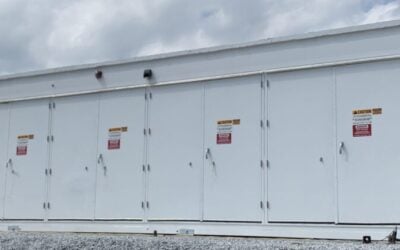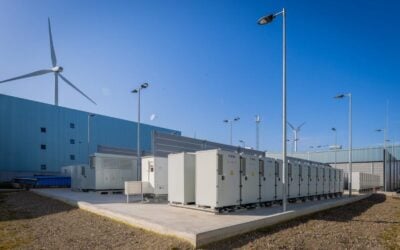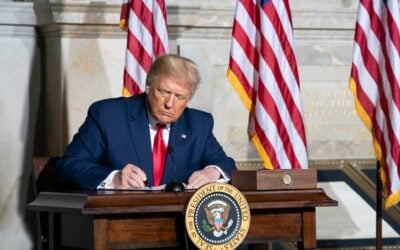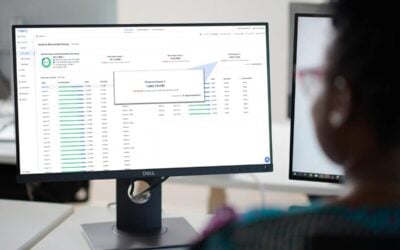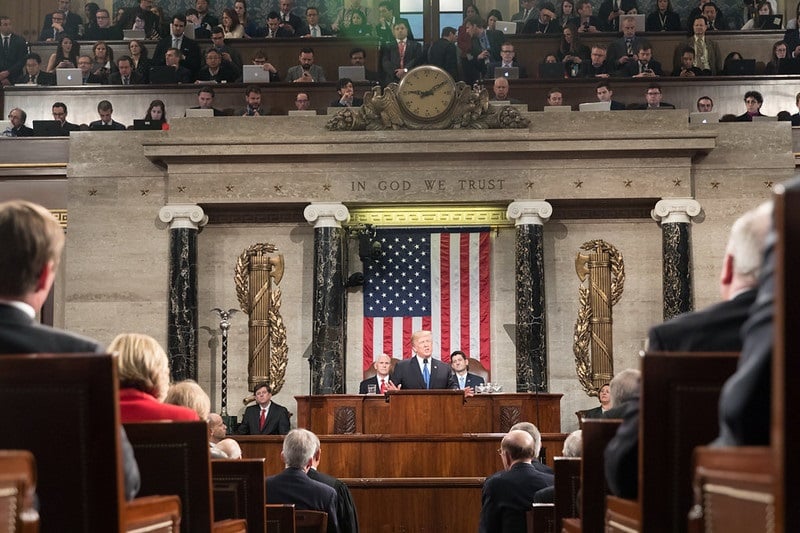
Tariffs announced on Donald Trump’s ‘Liberation Day’ have already caused battery storage project deals to fall through in the US, Energy-Storage.news has heard.
When unveiled on 2 April, the wave of so-called ‘reciprocal’ tariffs based on countries with which the US has a trade deficit, alongside 10% across-the-board tariffs, looked set to be levied on US importers of goods from almost every country the US does business with, creating shock waves in global markets.
Enjoy 12 months of exclusive analysis
- Regular insight and analysis of the industry’s biggest developments
- In-depth interviews with the industry’s leading figures
- Annual digital subscription to the PV Tech Power journal
- Discounts on Solar Media’s portfolio of events, in-person and virtual
Or continue reading this article for free
They were due to come into effect 9 April, but the US Republican president hit the pause button instead, giving a 90-day reprieve. Representatives of various governments are reportedly seeking to enter negotiations.
However, the direction of tariff policy on China has gone the opposite way since 2 April. The White House’s trade war with the Asian powerhouse has escalated rapidly. China’s government slapped retaliatory tariffs at 84% on US imports after the initial announcement. Trump responded by upping import tariffs on Chinese goods to 125%.
US battery energy storage system (BESS) industry supply chains are heavily reliant on Chinese imports. The effects of ‘Liberation Day’ were “rapid and clear for the energy storage sector” in the US, Rosa van Reyk, senior underwriter at GCube, a global insurance provider specialised in utility-scale renewable energy projects, told Energy-Storage.news.
Speaking with the site last week shortly before the pause was announced, van Reyk said that projects “that were on the verge of breaking ground were postponed indefinitely.”
“For example, we know of a co-located solar and storage project abandoning its BESS element, valued at US$650 million, and another project pressing pause on a US$750 million investment.”
The underwriter noted that the renewable energy community is “opportunistic and nimble,” accustomed to being flexible for many years to accommodate rapid changes in technology and fiscal policy.
“That said, it’s frustrating for owners and developers to see the ground shifting to this extent,” van Reyk said.
Even under Democrat predecessor Joe Biden, the government had not wanted to look soft on China. Tariffs had already been set for an increase to 25% next year, had Trump’s election rival Kamala Harris won.
While it is thought Trump’s tariffs are partly aimed at getting the US back to manufacturing and domestic content sourcing, rather than importing products from abroad, Biden’s Inflation Reduction Act (IRA) and Bipartisan Infrastructure Law policies that the new administration appears intent on pulling back from had been among drivers in stimulating a wave of investment in battery storage manufacturing within the US.
“The IRA galvanised US renewable energy, [it] created jobs and a frenzy of activity in the sector. The tariffs have the potential to apply the brakes, though to what extent is unclear,” added van Reyk.
As we heard last week in a guest blog for this site from Anjali Joshi, energy storage market intelligence analyst at Clean Energy Associates (CEA), the waves of policy uncertainty have in recent months instead led to battery manufacturers, particularly startups and smaller players, cancelling or postponing gigafactory developments.
Low-cost batteries, stockpiling will preserve momentum
However, according to Iola Hughes, head of research at Rho Motion, which specialises in EV and battery storage industry forecasting and analysis, the impact on the US battery storage industry from the extreme tariff hikes on imported battery components and systems may be limited.
The US industry has been prepping for tariffs to go up, even if the levels to which Trump – and China in return – appears prepared go had not been anticipated.
“In the immediate term, the US storage market is relatively well prepared to handle the tariffs with many integrators and developers building cell/system stock over the last few months in anticipation of tariffs,” Hughes told Energy-Storage.news in an interview.
“Projects planned for the end of this year and 2026, when stockpiles have been exhausted, will be those most likely to feel the tariff impact. However, this does give some time to reevaluate supply chains and negotiate new prices.”
Furthermore, Hughes said that there is some room for dealing with the additional costs, although the “headline tariff figures are bad.”
The US BESS industry is dependent on China for about 90% of its supply chain, but as regular readers of Energy-Storage.news will know, the costs of batteries and energy storage systems have fallen significantly over the past decade or so, including roughly halving in the past two years, as Hughes notes.
“Battery prices have dropped sharply since 2022, and innovations in cell and system energy density mean smaller footprints and less equipment per megawatt-hour. In real terms, the tariff hit brings prices roughly back to 2022 levels,” Hughes said.
Chinese BESS industry players also have margin room, according to the Rho Motion analyst. US prices have fallen, but Chinese prices have fallen even faster, widening margins for suppliers from China in the US market. That creates some headroom to absorb some of the tariff without eliminating profitability.
In other words, there is “potential for Chinese players to absorb some or part of the tariff due to the higher levels of margins currently achieved,” Hughes said, although she added that with the tariff level growing nearly every day, there will come a point where Chinese products reach prices that make them unviable, which would leave the US market with demand outstripping supply.
Will tariffs ultimately benefit US manufacturing and supply chains?
“The increased tariffs, combined with the Investment Tax Credit (ITC) bonus adder for domestic content, means any player who can offer domestic US cells will be in even higher demand than they were previously,” Hughes said.
“However, supply remains constrained with just a handful of players manufacturing lithium iron phosphate (LFP) in the US. Most of these players will have all offtake already secured for the coming years.
“Additionally, those planning to establish LFP production in the US will also be facing higher prices. LFP cathode active materials (CAM) and precursor cathode active material (pCAM) production is concentrated in China to an even higher degree than cell production and will be until domestic LFP cathode production gets up and running, which is realistically still several years away,” Hughes said.
“Even for Korean manufacturers, such as LG Energy Solution, which plans to have LFP production in Michigan by the end of this year, a retooling of what was previously a nickel cobalt manganese (NCM) line for EVs will be at least initially reliant on China for LFP cathode materials, before supply can be established in South Korea.”
Hughes said LFP gigafactories in Southeast Asia could become a “strong alternative” since some countries in the region had already talked the US president down from the high reciprocal tariffs.
“These players, using Chinese CAM and pCAM without facing tariffs, have the potential to offer a very attractive price to the US market, far below that of domestic players who will be facing rising costs.”
Van Reyk pointed out that in terms of materials further upstream, the world’s other two biggest lithium-producing countries, Chile and Australia were also hit by tariffs in the ‘Liberation Day’ big reveal.
While it remains to be seen if those two will negotiate successfully to lower those before the 90-day pause is up, if they don’t, the competitive advantage could be handed to non-US markets, which could see an opportunity for more affordable batteries, van Reyk said.
“As the US market contracts, it will be to the advantage of other buyers with whom countries have preferential trade deals.”
Van Reyk said reciprocal tariffs would likely also make US-made batteries a less appealing export. With Asian batteries likely to be more available and, in turn, competitively priced, non-US buyers could gain further advantage.
Tariffs, future of ITC fuel market uncertainty
Despite the ability to make some adjustments, such as refocusing on imports from Southeast Asian factories, the US BESS industry will likely have to “reshuffle or devalue elements of their supply chain where possible in the coming years,” Hughes said.
This could mean reduced demand for Chinese DC block systems while encouraging US developers to opt for domestically made or otherwise non-China-produced systems to minimise tariffs and maximise domestic content to benefit from ITCs.
As with so much in the industry today, it could be that having to ‘wait and see’ what happens next on tariffs is the policy uncertainty that causes the most challenges, rather than tariff-based cost increases per se.
Meanwhile, the IRA broadened the base of technologies eligible for ITCs to include standalone energy storage and gave bonus incentives to projects using domestic content. These were set to be available until 2032 and the industry had welcomed the certainty that the ten-year scheme had brought it. That its future now hangs in the balance could be an even bigger negative disruptor than tariffs.
“In the near term, I would say the primary focus [for the US industry] is on navigating policy uncertainty, securing bankable supply chains, and managing cost volatility (aka tariffs),” Hughes said.
Hughes noted that beyond tariffs, the future of ITCs is “front of mind,” adding that positive signs from Republican senators in their approach to the tax-based incentives over recent days “may help placate those concerns.”

